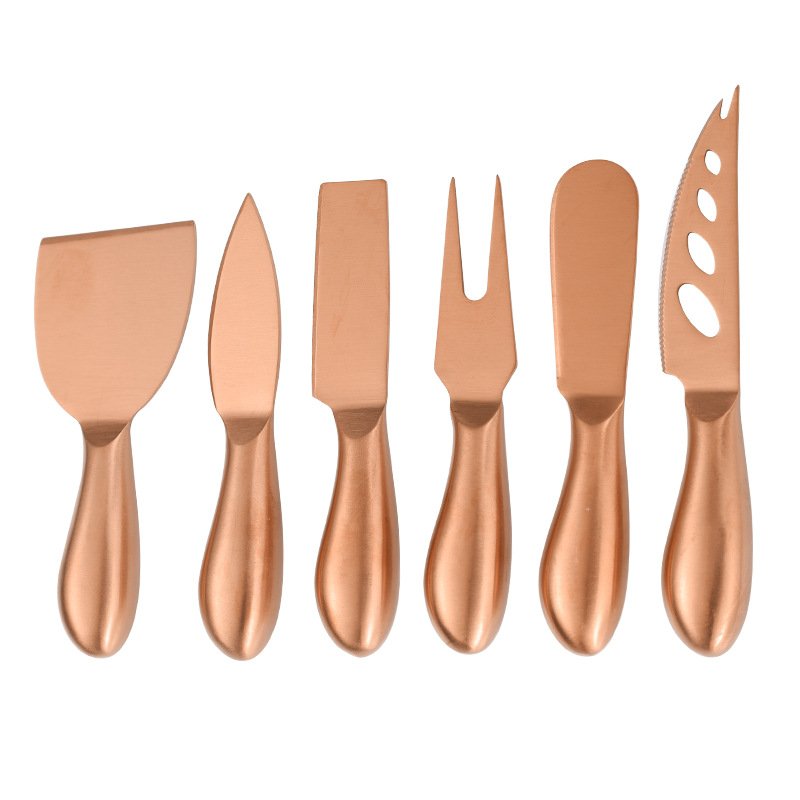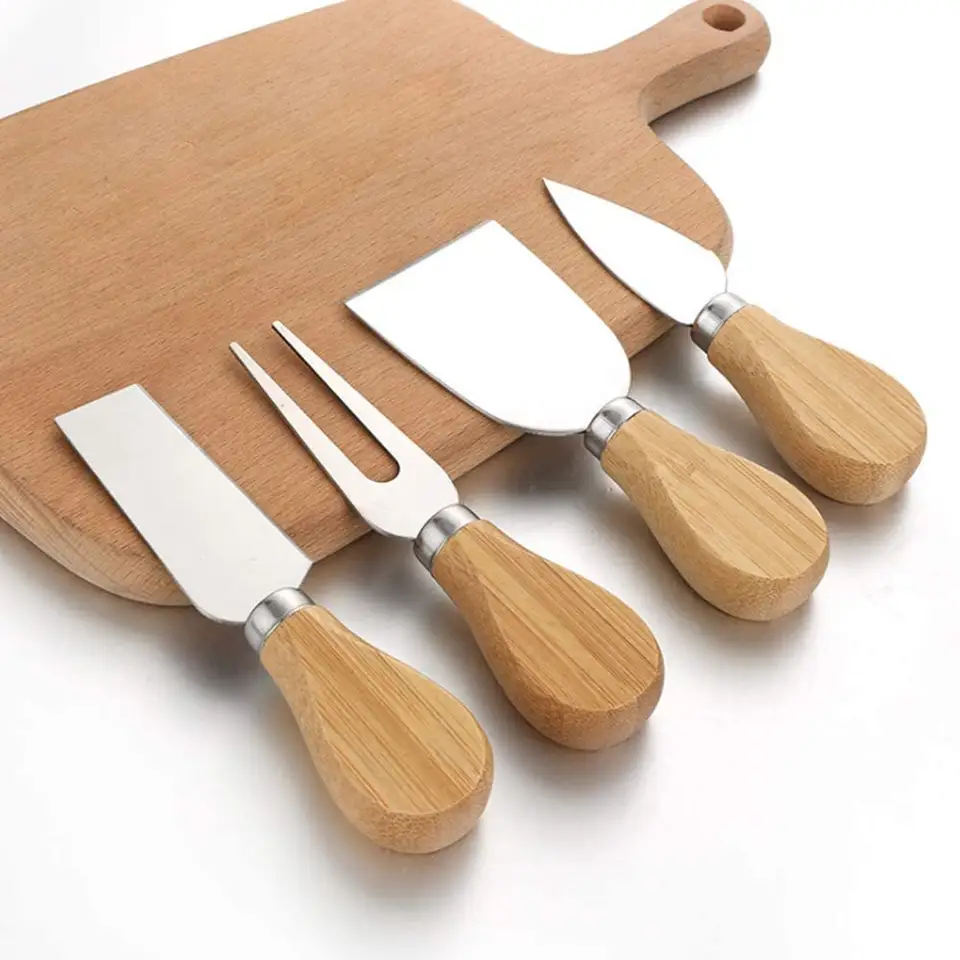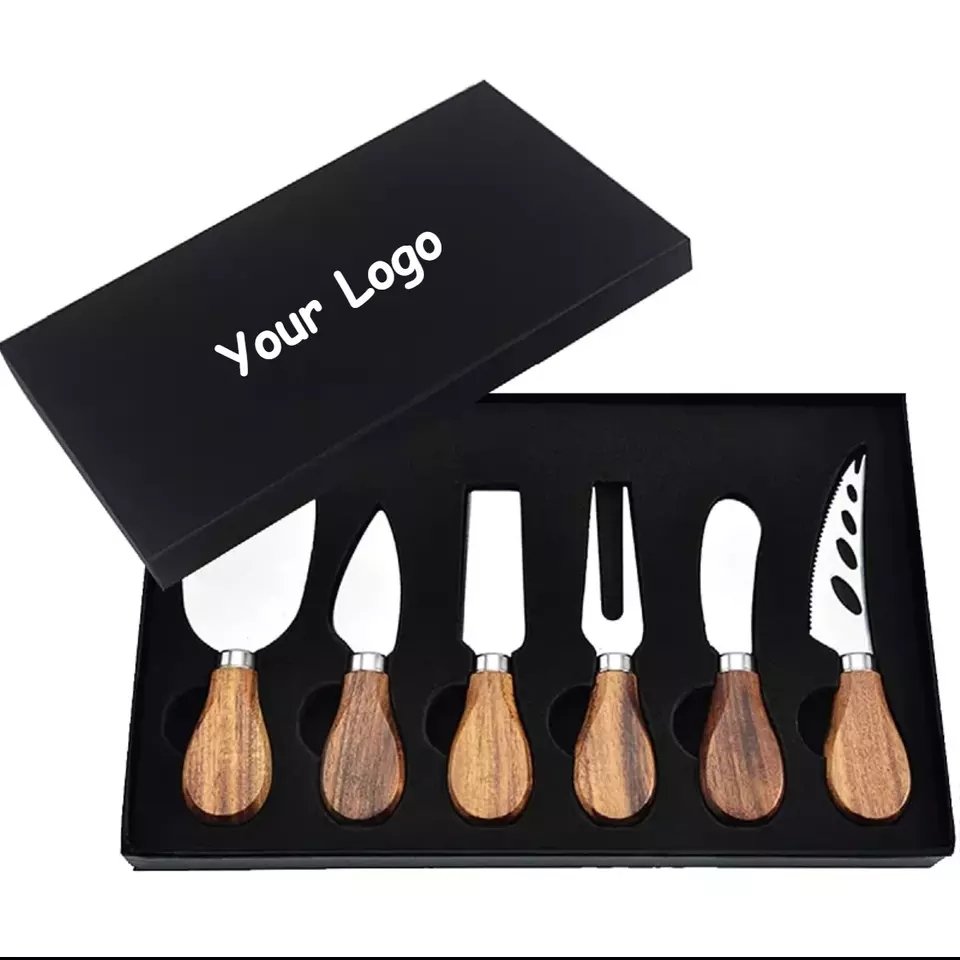Feeling overwhelmed by the sheer number of options available? Don’t worry. Finding the perfect set to meet your needs doesn’t have to be overwhelming.
Cutlery sets come in various types, styles, and materials to suit different occasions and preferences. By understanding the distinctions, you can choose the ideal set that complements your dining experience.
Let’s explore the wide world of cutlery and learn how to pick the perfect set for any occasion.
Table of Contents
Types of Cutlery and Their Uses
Have you ever wondered why each piece of cutlery at the dining table is different?
Each type of cutlery is designed for specific uses, ranging from everyday meals to formal dining. Understanding these differences enhances your dining experience.
Cutlery includes knives, forks, and spoons of different shapes and sizes. For example, dinner knives are used for main courses. Butter knives are smaller and used for spreading. Knowing the types of cutlery and their uses ensures proper etiquette and functionality at the table.

10 Types of Cutlery: Essential Choices for Every Table
What are the essential cutlery pieces you need for a complete dining set?
A comprehensive cutlery set often includes 10 essential types: dinner knife, dinner fork, salad fork, soup spoon, teaspoon, butter knife, steak knife, dessert fork, dessert spoon, and serving utensils.
These pieces cover all the courses and dishes you’ll serve, making your dining experience complete. Whether you’re hosting a formal dinner or sitting down to a casual meal, having these 10 types of cutlery means you’re ready for anything.
Types of Cutlery Materials: Which Is Right for You?
Does the material your cutlery is made of make a difference in your dining experience? You bet it does!
Cutlery materials range from stainless steel, bamboo, and plastic to silver and titanium. Each material offers different aesthetics, durability, and maintenance levels.
Stainless steel cutlery is popular for its durability and good looks. Bamboo cutlery is perfect for eco-conscious people who want a sustainable option. Plastic cutlery is great for single-use situations. Silver cutlery adds a touch of elegance to formal settings. Knowing the types of cutlery materials helps you choose based on your preferences and needs.
What are the different types of cutlery?
Ever opened a cutlery catalog and felt completely lost by all the names?
There are over a dozen types of cutlery pieces, each designed for a specific task like cutting, scooping, or spreading.
Cutlery isn’t just forks, knives, and spoons. Each piece has a role. Understanding what each does can help you pick the right tools for your table.
Main Types of Cutlery and Their Use
| Cutlery Piece | Purpose | Common Size |
|---|---|---|
| Dinner Knife | For cutting meat or vegetables | 8–9 inches |
| Dinner Fork | For main meals | 7–8 inches |
| Soup Spoon | For soup or broth | 6–7 inches |
| Teaspoon | For stirring tea or eating yogurt/dessert | 5–6 inches |
| Dessert Fork | For pastries, cake, or fruit | 6–7 inches |
| Dessert Spoon | For mousse, pudding, ice cream | 5–6 inches |
| Butter Knife | For spreading butter or soft cheese | 5–6 inches |
| Fish Knife | For lifting and separating fish | 8 inches |
| Fish Fork | For delicate handling of fish | 7 inches |
| Steak Knife | For cutting thick meats, especially grilled steak | 8–9 inches |
| Salad Fork | For handling leafy salads | 6–7 inches |
| Serving Spoon | For serving food from a bowl or platter | 8–9 inches |
| Serving Fork | For picking up sliced meats or pasta | 9–10 inches |
Some sets even include items like ice cream spoons, fruit knives, and seafood forks. These pieces often come in premium or full-service sets.
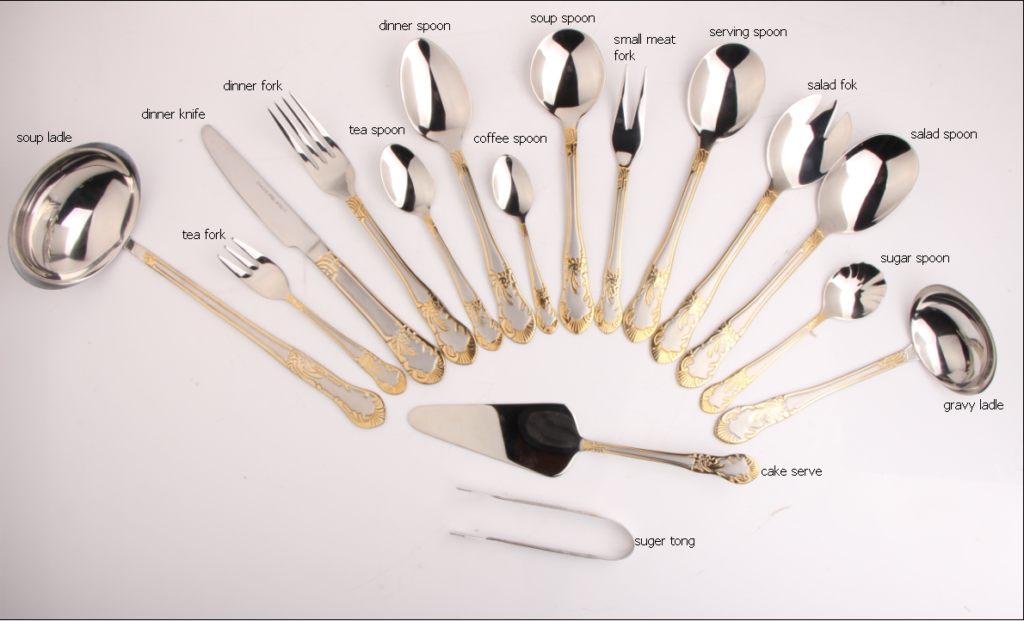
Why This Matters
If you run a hospitality business or want to create an elegant dining experience at home, knowing these types helps you set the right mood and function. I’ve seen restaurants struggle with customer complaints simply because they didn’t provide the right type of fork for a dish. Once they switched to proper cutlery, satisfaction improved instantly.
My Take
In my opinion, even if you’re not using every single piece every day, it’s smart to own a few full sets. When you’re hosting, those small details—like handing a guest a butter knife instead of a dinner knife for their croissant—can make a big impression.
What are the different types of cutlery patterns?
Do you ever wonder why some forks look like art while others look like tools?
Cutlery patterns refer to the design styles on handles—ranging from classic florals to modern minimalist lines.
A pattern isn’t just decoration—it’s how a cutlery set matches your dining vibe. The right pattern reflects your brand or personal taste.
Most Popular Cutlery Patterns
| Pattern Style | Description | Mood it Creates |
|---|---|---|
| Plain/Modern | Sleek, no ornamentation | Clean, contemporary |
| Floral/Vintage | Flowers, vines, scrolls | Traditional, romantic |
| Geometric | Lines, squares, dots | Trendy, modern |
| Hammered Finish | Textured surface | Rustic, artisanal |
| Baroque/Ornate | Heavy detail, engraving | Formal, luxurious |
What to Choose and When
If you’re a casual user, go for plain or geometric. They’re versatile and fit most table settings. If you host formal dinners or cater weddings, ornate or baroque styles work best. Some buyers I’ve worked with from Europe love vintage sets because they echo old-world charm. On the other hand, my Japanese clients often go for ultra-minimalist patterns—just polished metal, no lines, no frills.
Pattern vs. Finish
Don’t confuse patterns with finishes. A mirror finish gives a glossy look, while a satin or matte finish feels softer and less shiny. Some clients like combining hammered patterns with a matte finish for a handmade vibe.
Insider Advice
One client from Germany, a design-focused wholesaler, once told me their bestsellers weren’t the most detailed pieces—but the simplest ones. The pattern was barely visible, but the finish was flawless. That’s the power of minimalism done right.
What is the difference between flatware and cutlery set?
Confused by the terms “flatware” and “cutlery”? You’re not alone—many people think they mean the same thing.
Flatware usually includes all eating utensils (forks, spoons, knives), while cutlery refers more specifically to knives or the full knife-based set.
In North America, “flatware” is often used to describe any eating utensils, especially when they’re not sharp. In Europe and other regions, “cutlery” is the more common word.
Comparison Table
| Term | What It Includes | Common Use Region |
|---|---|---|
| Cutlery | Knives, forks, spoons (more traditional term) | UK, Europe, Asia |
| Flatware | Forks, spoons, sometimes knives (broader and more modern term) | USA, Canada |
| Silverware | Often used to describe high-end flatware, especially in silver | USA, formal settings |
Material Focus
“Flatware” usually implies non-sharp table utensils—think of what you get with a casual restaurant meal. “Cutlery” emphasizes cutting tools more. In factories and B2B markets, like mine, we often separate listings as “flatware sets” and “cutlery knives” to clarify.
Why This Matters for Buyers
When ordering from global suppliers, you must use the correct term. I once had a client from South Africa who ordered “cutlery sets,” expecting only knives. They received a 24-piece full set instead. Clarifying terms ahead of time saves both sides time and trouble.
My Advice
If you’re sourcing internationally, always check the supplier’s product description. Ask for photos and piece lists. In my business, I always include a diagram in the quote sheet to show exactly what’s inside each set. No guessing.
Types of Cutlery Materials?
Ever wondered why some cutlery feels heavier, shines more, or lasts longer than others?
Cutlery materials range from stainless steel to plastic to silver, and each material affects price, durability, and user experience.
Material isn’t just about how your cutlery looks—it impacts its weight, balance, feel, and how long it lasts. Choosing the right material means your cutlery will match your needs, whether that’s for a luxury restaurant or casual family dining.
Common Cutlery Materials and Their Features
| Material | Durability | Rust Resistance | Appearance | Price Range | Typical Use Case |
|---|---|---|---|---|---|
| Stainless Steel (18/10) | Very High | Excellent | Bright and shiny | $$$ | High-end hotels, premium home dining |
| Stainless Steel (18/0) | Medium | Good | Slightly duller | $$ | Everyday use, budget restaurants |
| Plastic | Low | Excellent | Varies by color | $ | Outdoor use, disposables |
| Silver/Sterling Silver | High | Moderate | Warm luster | $$$$ | Formal banquets, luxury occasions |
| Bamboo/Wood | Low | Poor | Natural look | $$ | Eco-friendly setups, Japanese dining |
| Titanium-coated | High | Excellent | Gold/Black tone | $$$ | Trendy, modern cutlery for restaurants |
| Gold-plated | Medium | Moderate | Elegant gold | $$$$ | Ceremonial or formal dining |
A Closer Look at Stainless Steel Grades
Most cutlery in the market is stainless steel, but not all stainless steel is equal. Here’s a simplified breakdown:
| Grade | Composition | Key Benefits |
|---|---|---|
| 18/10 | 18% Chromium, 10% Nickel | Best corrosion resistance, shiny appearance |
| 18/8 | 18% Chromium, 8% Nickel | Still great durability, slightly less shine |
| 18/0 | 18% Chromium, 0% Nickel | No nickel (allergy-safe), more affordable, less shine |
Nickel enhances shine and rust resistance. Chromium protects against stains. The absence of nickel makes 18/0 a good choice for those with allergies, but it may dull faster.
My Professional Opinion
From my experience, 18/10 stainless steel is the top performer for most use cases. It’s the most requested by European buyers, especially those in hospitality. For price-sensitive markets like Southeast Asia or parts of the Middle East, 18/0 is popular because of its affordability and decent performance. I always recommend choosing based on where and how the cutlery will be used.
Also, trends shift. In recent years, I’ve seen more demand for gold, black, and rainbow finishes. These are typically created by titanium-coating or PVD (Physical Vapor Deposition) processes. They’re not only eye-catching but also durable—perfect for Instagram-worthy restaurant plating.
Final Thought
The material you choose should match your market, your dining style, and your brand. Fancy-looking cutlery made from poor-quality metal will not just disappoint customers—it’ll ruin your reputation. Always balance beauty and function.
What Is a Standard Cutlery Set?
Stuck wondering what’s really included in a “standard” cutlery set? Many of my customers ask this when placing their first order.
A standard cutlery set typically includes a dinner knife, dinner fork, teaspoon, and soup spoon—usually for four or more people.
A standard cutlery set is the most common household choice. It’s designed for everyday use and basic meals. Most sets come in multiples of four, six, or twelve.
Types of Pieces Included
| Piece | Function | Typical Size |
|---|---|---|
| Dinner Knife | Cutting meat or vegetables | 8–9 inches |
| Dinner Fork | For main courses | 7–8 inches |
| Teaspoon | For desserts and stirring drinks | 5–6 inches |
| Soup Spoon | For eating soups or broths | 6–7 inches |
The standard set doesn’t usually include specialized items like steak knives or dessert forks. This makes it budget-friendly, but not ideal for those who host often or want complete tableware for formal meals.
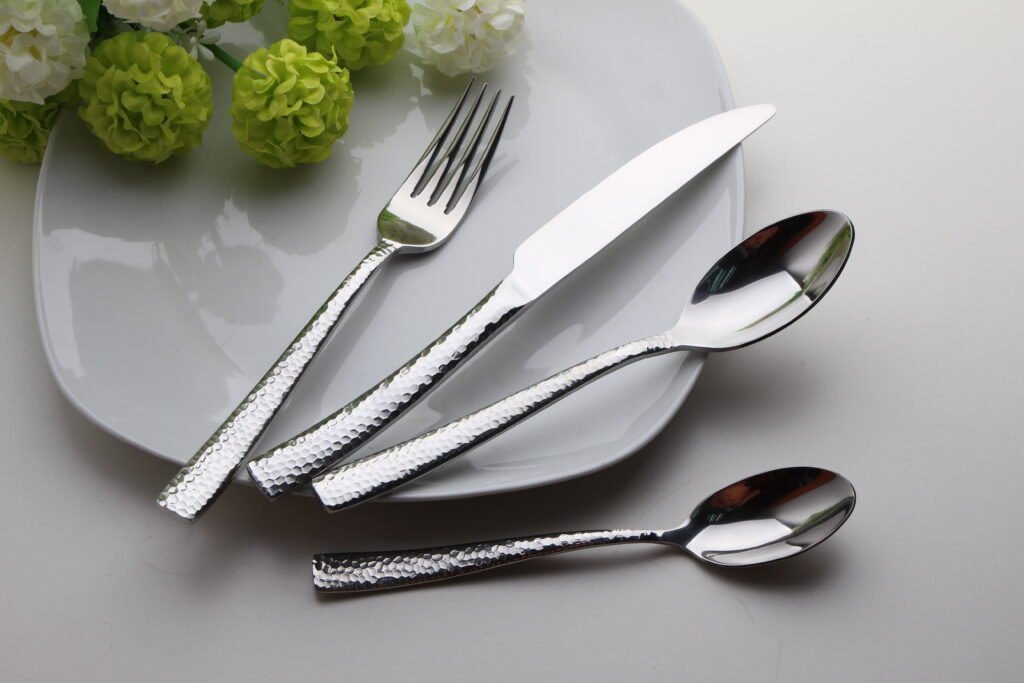
Is This Enough?
For casual use or small families, yes. But for hosts or those with more refined dining habits, standard sets can feel limited. I often recommend starting with a standard set and gradually adding specialty pieces.
My Experience
When I first stocked standard sets in my showroom, most clients thought they were “basic.” But once they saw the build quality and finish we offered, they realized even a basic set could look elegant and last years.


